12.1: Sushi
- Page ID
- 21269
\( \newcommand{\vecs}[1]{\overset { \scriptstyle \rightharpoonup} {\mathbf{#1}} } \)
\( \newcommand{\vecd}[1]{\overset{-\!-\!\rightharpoonup}{\vphantom{a}\smash {#1}}} \)
\( \newcommand{\id}{\mathrm{id}}\) \( \newcommand{\Span}{\mathrm{span}}\)
( \newcommand{\kernel}{\mathrm{null}\,}\) \( \newcommand{\range}{\mathrm{range}\,}\)
\( \newcommand{\RealPart}{\mathrm{Re}}\) \( \newcommand{\ImaginaryPart}{\mathrm{Im}}\)
\( \newcommand{\Argument}{\mathrm{Arg}}\) \( \newcommand{\norm}[1]{\| #1 \|}\)
\( \newcommand{\inner}[2]{\langle #1, #2 \rangle}\)
\( \newcommand{\Span}{\mathrm{span}}\)
\( \newcommand{\id}{\mathrm{id}}\)
\( \newcommand{\Span}{\mathrm{span}}\)
\( \newcommand{\kernel}{\mathrm{null}\,}\)
\( \newcommand{\range}{\mathrm{range}\,}\)
\( \newcommand{\RealPart}{\mathrm{Re}}\)
\( \newcommand{\ImaginaryPart}{\mathrm{Im}}\)
\( \newcommand{\Argument}{\mathrm{Arg}}\)
\( \newcommand{\norm}[1]{\| #1 \|}\)
\( \newcommand{\inner}[2]{\langle #1, #2 \rangle}\)
\( \newcommand{\Span}{\mathrm{span}}\) \( \newcommand{\AA}{\unicode[.8,0]{x212B}}\)
\( \newcommand{\vectorA}[1]{\vec{#1}} % arrow\)
\( \newcommand{\vectorAt}[1]{\vec{\text{#1}}} % arrow\)
\( \newcommand{\vectorB}[1]{\overset { \scriptstyle \rightharpoonup} {\mathbf{#1}} } \)
\( \newcommand{\vectorC}[1]{\textbf{#1}} \)
\( \newcommand{\vectorD}[1]{\overrightarrow{#1}} \)
\( \newcommand{\vectorDt}[1]{\overrightarrow{\text{#1}}} \)
\( \newcommand{\vectE}[1]{\overset{-\!-\!\rightharpoonup}{\vphantom{a}\smash{\mathbf {#1}}}} \)
\( \newcommand{\vecs}[1]{\overset { \scriptstyle \rightharpoonup} {\mathbf{#1}} } \)
\( \newcommand{\vecd}[1]{\overset{-\!-\!\rightharpoonup}{\vphantom{a}\smash {#1}}} \)
\(\newcommand{\avec}{\mathbf a}\) \(\newcommand{\bvec}{\mathbf b}\) \(\newcommand{\cvec}{\mathbf c}\) \(\newcommand{\dvec}{\mathbf d}\) \(\newcommand{\dtil}{\widetilde{\mathbf d}}\) \(\newcommand{\evec}{\mathbf e}\) \(\newcommand{\fvec}{\mathbf f}\) \(\newcommand{\nvec}{\mathbf n}\) \(\newcommand{\pvec}{\mathbf p}\) \(\newcommand{\qvec}{\mathbf q}\) \(\newcommand{\svec}{\mathbf s}\) \(\newcommand{\tvec}{\mathbf t}\) \(\newcommand{\uvec}{\mathbf u}\) \(\newcommand{\vvec}{\mathbf v}\) \(\newcommand{\wvec}{\mathbf w}\) \(\newcommand{\xvec}{\mathbf x}\) \(\newcommand{\yvec}{\mathbf y}\) \(\newcommand{\zvec}{\mathbf z}\) \(\newcommand{\rvec}{\mathbf r}\) \(\newcommand{\mvec}{\mathbf m}\) \(\newcommand{\zerovec}{\mathbf 0}\) \(\newcommand{\onevec}{\mathbf 1}\) \(\newcommand{\real}{\mathbb R}\) \(\newcommand{\twovec}[2]{\left[\begin{array}{r}#1 \\ #2 \end{array}\right]}\) \(\newcommand{\ctwovec}[2]{\left[\begin{array}{c}#1 \\ #2 \end{array}\right]}\) \(\newcommand{\threevec}[3]{\left[\begin{array}{r}#1 \\ #2 \\ #3 \end{array}\right]}\) \(\newcommand{\cthreevec}[3]{\left[\begin{array}{c}#1 \\ #2 \\ #3 \end{array}\right]}\) \(\newcommand{\fourvec}[4]{\left[\begin{array}{r}#1 \\ #2 \\ #3 \\ #4 \end{array}\right]}\) \(\newcommand{\cfourvec}[4]{\left[\begin{array}{c}#1 \\ #2 \\ #3 \\ #4 \end{array}\right]}\) \(\newcommand{\fivevec}[5]{\left[\begin{array}{r}#1 \\ #2 \\ #3 \\ #4 \\ #5 \\ \end{array}\right]}\) \(\newcommand{\cfivevec}[5]{\left[\begin{array}{c}#1 \\ #2 \\ #3 \\ #4 \\ #5 \\ \end{array}\right]}\) \(\newcommand{\mattwo}[4]{\left[\begin{array}{rr}#1 \amp #2 \\ #3 \amp #4 \\ \end{array}\right]}\) \(\newcommand{\laspan}[1]{\text{Span}\{#1\}}\) \(\newcommand{\bcal}{\cal B}\) \(\newcommand{\ccal}{\cal C}\) \(\newcommand{\scal}{\cal S}\) \(\newcommand{\wcal}{\cal W}\) \(\newcommand{\ecal}{\cal E}\) \(\newcommand{\coords}[2]{\left\{#1\right\}_{#2}}\) \(\newcommand{\gray}[1]{\color{gray}{#1}}\) \(\newcommand{\lgray}[1]{\color{lightgray}{#1}}\) \(\newcommand{\rank}{\operatorname{rank}}\) \(\newcommand{\row}{\text{Row}}\) \(\newcommand{\col}{\text{Col}}\) \(\renewcommand{\row}{\text{Row}}\) \(\newcommand{\nul}{\text{Nul}}\) \(\newcommand{\var}{\text{Var}}\) \(\newcommand{\corr}{\text{corr}}\) \(\newcommand{\len}[1]{\left|#1\right|}\) \(\newcommand{\bbar}{\overline{\bvec}}\) \(\newcommand{\bhat}{\widehat{\bvec}}\) \(\newcommand{\bperp}{\bvec^\perp}\) \(\newcommand{\xhat}{\widehat{\xvec}}\) \(\newcommand{\vhat}{\widehat{\vvec}}\) \(\newcommand{\uhat}{\widehat{\uvec}}\) \(\newcommand{\what}{\widehat{\wvec}}\) \(\newcommand{\Sighat}{\widehat{\Sigma}}\) \(\newcommand{\lt}{<}\) \(\newcommand{\gt}{>}\) \(\newcommand{\amp}{&}\) \(\definecolor{fillinmathshade}{gray}{0.9}\)Sushi
In Japanese cuisine, sushi (寿 司, 鮨, 鮓) is vinegared rice, usually topped with other ingredients including fish (cooked or uncooked) and vegetables. Outside of Japan, sushi is sometimes misunderstood to mean the raw fish by itself, or even any fresh raw-seafood dishes. In Japan, sliced raw fish alone is called sashimi and is distinct from sushi, as sashimi is the raw fish component, not the rice component. The word sushi itself comes from an outdated grammatical form of a word that is no longer used in other contexts; literally, sushi means “it’s sour.”
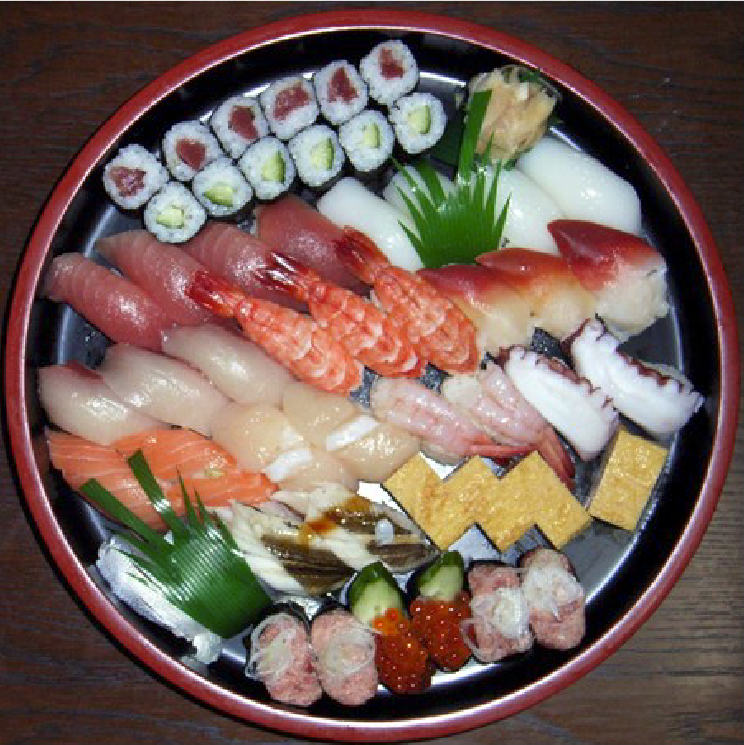
Sushi must contain rice, typically contains nori (and sometimes seaweed), and virtually always includes fillings or toppings such as of various types, such as seafood, chicken, tuna etc., the possibilities of which are endless. Similar to Western appetizers (although sushi is often intended to be the main course), sushi should be served in a manner that will allow eating by hand, usually in a bite or two. Many types of sushi are individually made by the cook to the appropriate size or are cut by the cook to this size before serving. Although sushi may be prepared in a wrap or roll format prior to serving, traditional ingredients lack the structural strength needed to allow them to be eaten by hand as an entire roll or wrap.
Sushi, in its simplest forms, is made by first cooking rice, then cooling it, molding by it hand or in a mold and adding a topping, or wrapping the rice in nori and adding fillings to make a roll, using a bamboo mat to help, which is then cut into smaller pieces. Usually served cool and with soy sauce, sliced ginger, and wasabi.
Sushi can be eaten as served by the cook or dipped into (or, using sliced ginger as a ‘brush’, wiped with) soy sauce and then eaten, with additional wasabi added by the brave. As a general rule, it is always appropriate to eat sushi by hand, unless it is obvious that you cannot avoid getting rice or other ingredients stuck to your fingers, in which case chopsticks should be used. Much care is put into the creation of the dish and the many methods of preparing the food indicate the importance of appearance to the educated consumer.
History
Beginning as a method of pickling fish centuries ago, sushi has evolved into an artful, unique dining experience. In its earliest form, fish was placed between two wads of rice, producing a moderately complex chemical reaction as the fish fermented, helping to preserve it. Sometime between the 14th and 16th centuries, rice vinegar started to be added to the rice to help speed up the process which took several months. Around this time the rice also started to be consumed with the fish it was used to preserve. Nori (red algae seaweed paper) was added about this period as a way to keep one’s fingers from getting sticky, thus creating the first ancestor of modern ‘makizushi’, or rolled sushi.
Sometime in the mid to late 18th century, a restaurant in Edo (modern Tokyo) started serving sushi rice alone with thinly sliced fresh fish pressed into it. This was the start of Edo-Mae sushi, which is also known as ‘nigirizushi’, or pressed sushi
Sometime after this, a chef took this one step further and eliminated the sushi rice all together: the birth of sashimi. It is important to note that sashimi specifically refers to thinly sliced raw or mostly raw fish and shellfish.
It is hard to tell when exactly the wasabi and pickled ginger were added, but it is probable they came in with the Edo-Mae sushi, as this was when the focus of sushi became enjoying the taste of the exceedingly fresh fish, and the condiments heighten the experience.
Sushi types include makizushi, nigirizushi, oshizushi, and inarizushi.
Makizushi
Makizushi (rolled sushi), or maki for short, is the kind that is most common to North American consumers (see California Rolls) as it is basically sushi layered on top of nori, rolled into a tube, and cut into thick slices. Easy to make and even easier to mass produce, it has found a wide proliferation as a new form of fast food, but still manages to be found in Japanese restaurants that still respect the tradition.
Nigirizushi
Nigirizushi (hand formed sushi), or nigiri for short, is, as stated above, a hand-formed small bed of rice with an ingredient on top (ranging from tuna or salmon to eel or egg). Nigiri sushi that is served without the rice is called sashimi. Gunkanmaki (battleship roll or boat sushi) is a nigirizushi where an oval piece of sushi rice is surrounded by nori and topped with a topping such as fish eggs.
Oshizushi
Oshizushi (pressed sushi) is similar to nigirizushi but it is formed by pressing with the aid of an oshibako, a wooden mold. Generally, the topping is placed in the oshibako first, the rice is added on top, and then the combination is pressed together with the oshibako top or lid. After pressing, the sushi is removed and cut to serving sizes.
Inarizushi
Inarizushi (stuffed sushi) is generally a pocket or pouch containing the rice and other ingredients. Materials used to make the pocket include tofu, bean curd, egg, and cabbage leaves.
Sashimi
Sashimi (basically sliced raw seafood, mostly fish without any rice) is often the most artistic form, with thin slices of fish and shellfish being formed into a range of different shapes, especially flowers. While technically not sushi, sashimi is often grouped together with the different types of sushi.
Saikuzushi
Saikuzushi is an artistic type of sushi, which makes a beautiful image. It is quite difficult to make this, and also quite expensive when bought. Rice is tinted with different colors and later sliced to make an image.
Chirashizushi
Chirashizushi, is scattered sushi with rice in a box or bowl and seaweed on top. Different kinds of seafood and fish are placed on top, including octopus, squid, tuna, alongside with chopped cucumbers and green onion. Chirashizushi has two main regional types, the version of Tokyo, and
the Osaka Version.
Edomae, or Temakizushi, is one of the most common types of sushi, with rice and fish rolled up in seaweed. Crab, octopus, tuna, shrimp, and several other types of seafood is rolled up inside the rice. It is even found in convenience stores in Japan.
Eating Sushi
An authentic sushi-eating experience can include miso soup, makizushi (sushi rolls), sashimi (pieces of fish with no rice), nigirizushi and garnishes of wasabi, soy sauce and pickled ginger. Hot, fresh, green tea is an excellent beverage to drink with your meal, as is beer or plain water. While sake can be consumed with sushi, because it is made from rice it is considered to be too much rice in one meal.
In Japan, sushi chefs will apply a small amount of wasabi to the appropriate types of sushi during preparation. For example, sushi that features its own unique sauce will be prepared sans wasabi so as not to compromise the flavor. Western sushi chefs may do this, but some may not apply wasabi to any sushi.
Sushi can be eaten with chopsticks or by hand; nigiri sushi in particular may be eaten by hand because the rice is packed lightly and may fall apart if eaten with chopsticks.
Start your meal with simple miso soup but do not spend too much time on any one item as this is the proper Japanese etiquette. Instead, rotate through your meal to appreciate the quality of each aspect. Many people start with a mild sushi, such as tamago (a sweet, cold omelet on rice), and end with a stronger taste at the end of the meal, like a darker fish. Between different items it is recommended that a piece of pickled ginger be eaten to cleanse the palate and ensure that none of the subtle flavors of the sushi is missed.
There are different types of seafood used for sushi, and the most common ones are tuna, salmon, squid and octopus. Using expensive seaweed makes sushi taste much better. Expensive seaweed is darker in color, and is less likely to break when folded or rolled. Cheap seaweed is usually greenish in color. The type of soy sauce (shoyu) used also affects the taste of the sushi; the most commonly used brands are Kikkoman and Yamasa. Many people like to mix wasabi, which is a green colored, spicy condiment with their shoyu, which makes it quite spicy and wakening.
Condiments
Sushi is generally served with
- Wasabi
- Green horseradish (a cheap wasabi substitute) gari (pickled ginger)
- Soy sauce
- Kabayaki sauce (eel sauce) (often served on some sushi, may be used for dipping instead of soy sauce
Retrieved from “https://en.wikibooks.org/w/index.php...&oldid=2694080”
Sushi / Sushi Rice
Sushi rice, termed sushi meshi or shari in Japanese, is a key ingredient for sushi and a staple of Japanese cooking. It consists of short-grain rice dressed with seasoned vinegar called sushisu. The rice is then cooled and dried for easy manipulation and to give a glistening appearance.
Ingredients
- 300g of uncooked, washed, short-grain Japanese rice
- (The Japanese measure their uncooked rice using a measurement called a Gō. This is roughlyequivalent to 150 grams when used to measure Japanese rice. One Gō is also the standard size of a rice cooker’s measuring cup)
- 400 mL of water
- 1 small sheet of Kombu (optional)
- 1 metric tablespoon (15 mL) of Sake (optional)
Sushisu (Seasoned rice vinegar dressing):
- 3 metric tablespoons (45 mL) of rice vinegar
- 1 to 2 metric tablespoons (12 to 24 g) of sugar (depending on how sweet you prefer it) 1 to 1.5 metric teaspoons of sea salt
Utencils
Rice cooker, Hangari (rice barrel), optional Shamoji (rice paddle), optional Fukin (cloth), optional
Procedure
- About 30 minutes before starting, fill the hangiri with water and let it stand. The water saturates the wood, which prevents the rice from sticking to it.
- Make the sushisu
- Mix the vinegar, sugar, and salt
- Heat the mixture in a sauce pan until everything is dissolved, but do not boil.
- Set aside to cool.
- Cook the rice
- Rinse the rice. Put the rice in the cooking pot, half filled with cold water, and swirl it around with your hand. The water will turn chalky white. Carefully drain off the water, and repeat the process several times, until the water remains clear.
- Allow the rice to stand for 30 minutes. Some recipes say the rice should remain in the cooking pot submerged in its cooking water; others say to transfer it temporarily to a colander to drain.
- Add an 8cm-sized sheet of Kombu to the cooking pot, and the sake if you are using it.
- Boil the water in the cooking pot.
- Remove the Kombu from the cooking pot just as the water boils, and reduce the heat.
- Simmer the water and rice in the cooking pot for 20 minutes.
- Turn off the heat but do not remove cover from the cooking pot for 10 minutes (no peeking).
- Note: A rice-cooker is often used instead of a cooking pot; these generally produce good, consistent results. The manufacturer’s directions will generally be similar to the above.
- Add the dressing to the rice. The rice and sushisu should be mixed immediately after the rice is finished cooking with sushisu at room temperature.
- Transfer the rice from the cooking pot to the hangiri; if you do not have one, use a large bowl or cookie sheet.
- Cut the sushisu gently into rice with the paddle, trying not to break the kernels. (For Western chefs: this “cutting” motion is similar to the cut-and-fold used for gentle treatment of egg whites.) When finished, the rice is evenly coated with the dressing, giving it a shiny appearance.
- Cover the rice with a cloth for a couple of minutes so the dressing is absorbed.
- Cool the rice to body temperature by fanning it, while continuing to cut it with the spatula. A traditional hand fan or modern battery-powered fan may be used.
Note: Some sushi chefs prefer natural cooling, rather than fanning, and instead let the rice rest in the hangiri for fifteen minutes, then re-cut the rice, and continue with this process until the rice is cool.
Hangiri
In Japanese cuisine, a hangiri (半切 or 飯切), also known as handai (飯台, a rice table or rice bowl) or sushi oke, is a round, flat-bottomed wooden tub or barrel used in the final steps of preparing rice for sushi.[1] Traditional hangiri are made from cypress wood bound with two copper bands. They range in diameter from about 30 cm (1 ft.) for use at home, to 1 meter (3 feet) for use in a restaurant.
The hangiri and a shamoji wooden paddle are used to dress and to cool the rice. After cooking, the rice is transferred to the hangiri where it is tossed with a dressing made of rice vinegar, sugar, and salt. When the mixing is complete, it is covered with a cloth (fukin) and allowed to cool. A typical hangiri may cost two or three times as much as an expensive steel cooking pot.
Shamoji
A shamoji (杓文字, しゃもじ) or rice paddle is a large flat spoon used in East Asian cuisine. It is used to stir and to serve rice, and to mix vinegar into the rice for sushi. Shamoji are traditionally made from bamboo, wood, or lacquer, and nowadays often from plastic. The shamoji is dipped in water frequently during use to prevent rice from sticking to it. Some expensive plastic shamoji have non-stick surfaces. Metal is rarely used, as this is more likely to cut rice grains or to damage the hangiri wooden tub traditionally used for mixing.
Modern rice cookers may include a shamoji in the box, usually made of white plastic. Shamoji are also used to crush vegetables, such as garlic and cucumbers, as cleavers are used in Western cuisine. The shamoji has also been a symbol of unity between the mother and wife in Japanese society. In one tradition, it was passed down from one generation to the next to symbolize the family duties that were handed down.
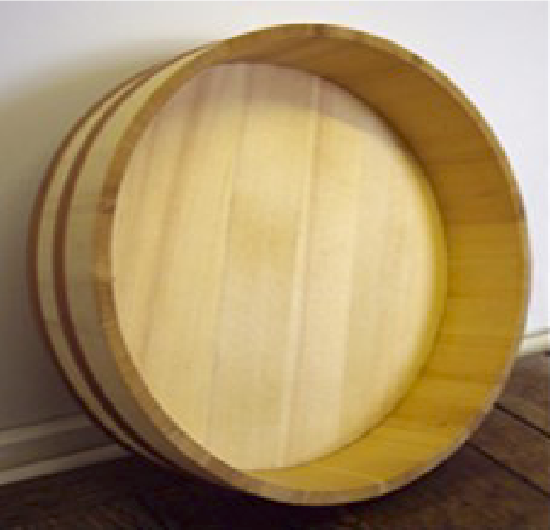
Hangiri - Wiki a hangiri. This example is 41 cm (16 inches)
in diameter. media commons
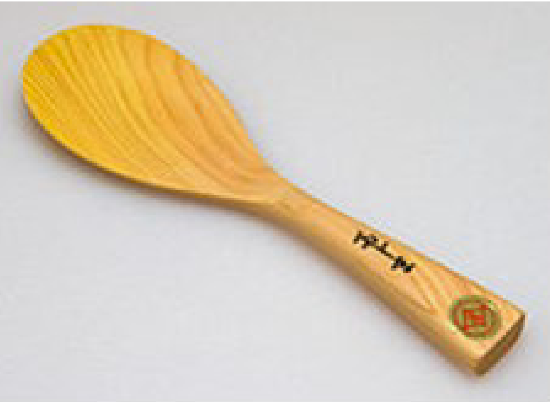
Traditional Shamoji - Wikimediacommons
Sushi / Maki
Ingredients
- Sushi rice (all of it prepared directly beforehand)
- Fish/vegetables (this may consist of either raw/smoked salmon, tuna, etc or perhaps cucumber or avocado) Sheets of nori (red algae seaweed paper).
- You must also have a makisu or sushi roller (bamboo sticks strung together with string) Wasabi paste, powders should say how to make them into paste.
- Water
- Plastic wrap, if making inside-out rolls with rice on outside
- Sesame seeds, if making inside-out rolls with rice on outside (optional)
Instructions
- Take the roller and place it on top of a cutting board. If making inside out rolls with rice on the outside, make sure your makisu (roller) is completely wrapped in a double layer of plastic wrap. This task is simple and effective in keeping rice from sticking to where it shouldn’t and especially sanitation. Finally, put a sheet of nori shiny side down on top of the makisu. Lengthwise or longwise depends both on the roll and amount of ingredients are being rolled.
- Dampen your hands before applying the rice. This will prevent clumping and the rice sticking to your hands, but may also make the rice less sticky, so don’t go overboard. Grab the rice with one hand and put a fistful on the center of the nori. When spreading this, leave a 2 centimeter gap on the side parallel to the bamboo. As a general rule, if you can’t see the nori through the rice, you have too much. A 6mm layer has been recommended.
- If making an inside out roll, flip over the nori and rice quickly onto the makisu. So as the rice is now on the surface of the mat and the nori is facing you.
- Next place the primary ingredients in a row in the middle. Then, slowly use the roller to push the nori against itself (rolling it away from you), using your thumbs and heels of hands for stability. Be careful when you reach the row of ingredients, making sure that it goes underneath the roll rather than just being pushed along.
- When you reach the end of the nori sheet, use the roller to compact the roll a little, making sure the rice is making it all stick together. Trying to even out a bumpy roll is simple, and it’s really just a matter of hand pressure. Don’t squeeze too hard on the sides and don’t flatten the roll from the top. If you want to fix the ends of the roll, just poke about 1/2 an inch out from one side of mat and while gently holding it in place, press it with the heel of your hand a little.
- Next remove the maki from the sushi roller, and put it on the cutting board below.
- Before you cut, wet your knife every time to reduce sticking (don’t do it sparingly this time). This can be done using a sink, a large bowl, or a large plastic cup. A knife with dimples supposedly works well for cutting sushi. Slice the rolls from the inside out, into sections of 5, 6, or 8 (depending on roll). Cutting from the inside first will ensure that all ingredients that shift towards the outside two pieces. For the rolls of 6 or 8, cut from the center, then put one roll behind the other, and cut each half in half. If you were making an inside-out roll, you may wish to put on a line of sesame seeds primarily for garnish.
- Serve with soy sauce and something shallow for dipping. You may also want chopsticks, pickled ginger, and wasabi if culture allows. Sashimi, Miso soup, other sushi, or just general Japanese food is also often served alongside it. Green Tea is considered the drink of choice to have with sushi.
Guest Habits
Do not be surprised if someone asks for wasabi with their soy sauce. Although this might be rare or offensive in your culture, it is very common in North American and European cultures. Also, do not be surprised if someone eats it without chopsticks. This is also very common, this time in East Asia. Sushi was originally designed to be eaten that way, until someone discovered how yummy soy sauce made it taste, reducing its portability. It is a clean way to eat maki (not for other types of sushi); you don’t need to eat them with a fork or chopsticks. This phenomenon is similar to some cultures eating pizza with their hands, others with a fork and knife. It can be seen as unnecessary and idiotic, two good ways to eat food, or the sanitary and polite way.
Common Sushi Rolls
- California Roll: avocado, crab meat or imitation crab, cucumber.
- Tuna Roll: Tuna, wrapped in rice and seaweed. This same combination is used to make plain rolls with any other type of fish.
- Spicy Tuna Roll: Tuna, spicy sauce (mixture of Japanese mayonnaise and sriracha)
- Kamikaze Roll: Tuna, yellowtail, spicy sauce
- Philadelphia Roll: Salmon (either raw or smoked), cream cheese Cucumber Roll: Sliced cucumber.Vegan.
- Egg Roll: Sliced Egg Yellow. Vegetarian.
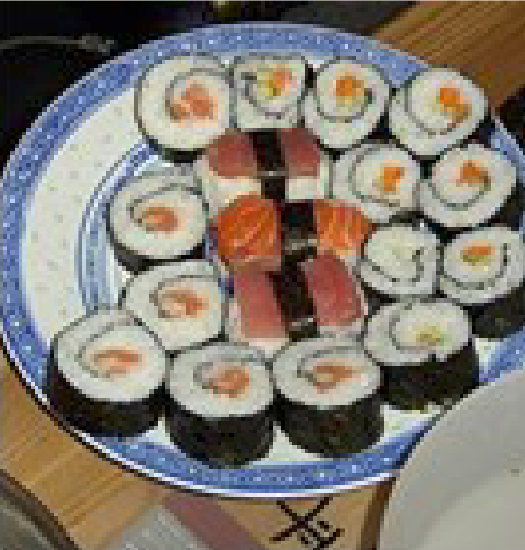
Wasabi
Also known as Japanese horseradish (Wasabia japonica), this green root is prepared by being ground, dried, and made into a paste. It is used in Japanese cooking and is often served with sushi.
Since the plant is difficult to grow, most wasabi sold outside of Japan is just European horseradish with green coloring added.
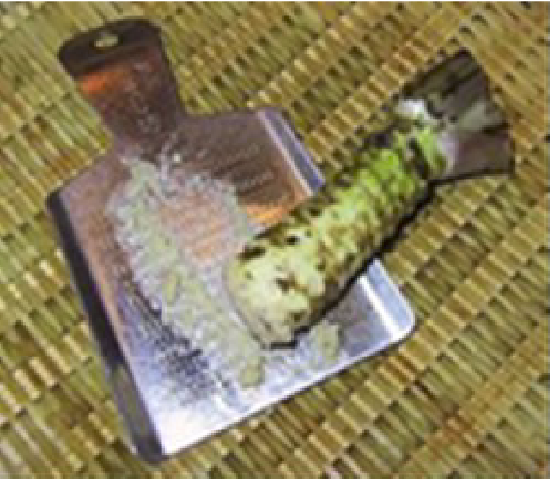
Wasabi
Wasabi (Japanese: 山葵 or 和佐比; scientific name Wasabia japonica (syn. Cochlearia wasabi, Eutrema japonica)) is a member of the cabbage family. Commonly known as Japanese horseradish, it grows naturally along stream beds in mountain river valleys in Japan. It is green and has an extremely strong flavor. Its hotness is different from chili pepper, which burns the tongue; wasabi’s strong sensations shoot up one’s sinus cavity instead. The historical purpose for wasabi is supposedly to kill the bacteria in the raw fish often used in sushi.
Edible Algae
Nori
Nori (海苔) is a Japanese term used to refer to edible varieties of algae in the various species of the red algae Porphyra, including most notably P. yezoensis and P. tenera. A few other algae are used as well, including some cyanobacteria. Nori is also commonly used to refer to the food products created from these so- called “sea vegetables”. Finished products are made by a shredding and rack- drying process that resembles papermaking. Nori is commonly used as a wrap for Onigiri and Makizushi.
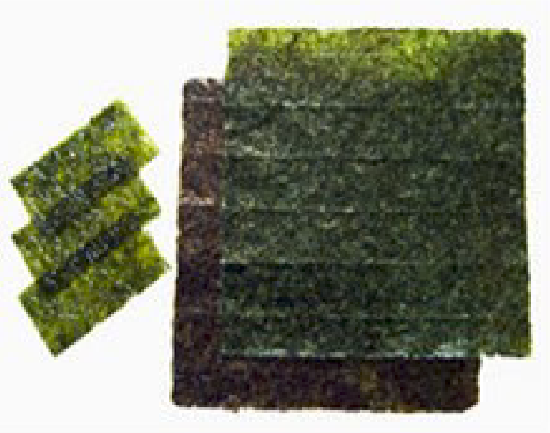
Nori
Nori is sometimes translated laver in English, but the term usually applies to plants of the genus Porphyra and not to the finished edible sheets of nori. The English term is in any case not well known, and in the United States, the term nori is more common.
Other edible algaes commonly served in Japan include wakame, which is usually dried nori baked and seasoned with sweet soy sauce.
References
- 杓文字(しゃもじ) - 語源由来辞典 (http://gogen-allguide.com/si/sy amoji.html)
- “Contemporary Japan: Culture & Society” (http: //afe.easia.columbia. edu/at_japan_soc/common/all.htm#society). 2004.
- Omae, Kinjiro (1994). The Book of Sushi. Kodansha International. ISBN 9784770019547.
- Retrieved from https://en.Wikipedia.org/w/index.php...ldid=873650172
- “https://en.wikibooks.org/w/index.php...&oldid=2694044”
Text is available under the Creative Commons Attribution-ShareAlike License; additional terms may apply. By using this site, you agree to the Terms of Use and Privacy Policy. Wikipedia® is a registered trademark of the Wikimedia Foundation, Inc., a non-profit organization.


